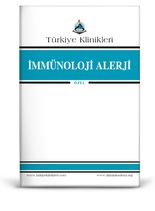Venom immünoterapisi (VİT) böcek sokmalarına bağlı anafilaksi riski yüksek olan kişilerde etkinliği kanıtlanmış tek tedavi şeklidir. Arı venomlarıyla yapılan VİT'nin bir sonraki arı sokmasında sistemik reaksiyon riskini %5'den aza indirdiği oysa tedavi olmayanlarda bu riskin %60 kadar yüksek olduğu gösterilmiştir. Böcek sokmasına karşı VİT ile tolerans gelişmesinin sağlandığı ortaya konmakla birlikte tedavinin tam mekanizması hala tam anlaşılamamıştır. Ancak son yıllarda T regulatuvar hücrelerden IL-10 ve TGF-beta salınımının antijene karşı immün supresyon oluşumunda önemli rol oynadığı bulunmuştur. VİT, arı sokmasından sonra sistemik reaksiyon öyküsü veren ve gerek deri testleri gerekse invitro yöntemle yapılan tanıya yönelik değerlendirmede pozitif sonuçlar elde edilen hem çocuk hem de yetişkin hastalarda uygulanmalıdır. Geniş lokal reaksiyon öyküsü olan çocuk ve yetişkinde, sadece deri bulguları ile ortaya çıkan solunum ve dolaşım sistemini tutmayan sistemik reaksiyonların görüldüğü çocuklarda bir sonraki arı sokmasında anafilaksi riski %10'dan azdır. Bu gibi olgularda VİT yapılması genellikle önerilmemektedir. Ancak hastada aşırı korkuya bağlı yaşam kalitesinin çok bozulması nedeniyle ve sık maruziyetin olduğu arıcıların ailelerinde VİT düşünülebilir. VİT'nin genel kontrendikasyonları diğer allerjen immünoterapisindeki ile aynıdır. Hangi venomların aşının içine dahil edileceği konusunda bir uzlaşma yoktur. Bazı otörler, eğer suçlu olan böcek kesin olarak biliniyor ve tanınıyor ise sadece onunla VİT yapılmasını, buna karşın bir diğer görüş ise deri testleri ve invitro testlerde pozitif sonuçların alındığı tüm venomların ekstresinin aşı içeriğine dahil edilmesini önermektedir. VİT için çeşitli başlangıç şemaları mevcuttur. Bunlar, birkaç enjeksiyonla 3-7 gün hatta 3.5 saat içinde 100 g (karma vespid venomu için 300 g) idame doza çıkılan hızlı protokoller ile 4-6 ayı alan yavaş doz artışı yapılan konvansiyonel şemalardır. İdame dozlar en az bir yıl süreyle ayda (4 haftada) bir kez verilmelidir. Ateş karıncası için doz artış şeması ile ilgili bilgiler yeterli değildir. VİT ile yan etki sıklığı inhalan allerjenle yapılan immünoterapiden daha fazla değildir. Bir kez başlandı mı tedaviye en az 3-5 yıl devam edilmesi önerilmektedir. Bu süre sonunda eğer deri testleri negatif olmuş, serumda spesifik IgE önemsiz düzeye inmiş ise tedavi kesilebilir. Ancak deri testi negatifleşmemiş, tedavi öncesi çok ciddi sistemik reaksiyon öyküsü olan, ya da VİT sırasında sistemik reaksiyon gelişen hastalarda belli bir süre daha VİT' ye devam edilebileceği de önerilmektedir. Ateş karıncası tüm vücut ekstresi ile yapılan immünoterapide tedavi süresi ile ilgili kesin veriler yoktur.
Anahtar Kelimeler: Arı sokması, Hymenoptera, venom, immünoterapi, hızlı (rush) tedavi şeması,idame doz, sistemik reaksiyon, yan etki
Venom immunotherapy (VIT) has proved to be extremely effective form of treatment for individuals at risk of insect sting anaphylaxis. VIT for bees, yellow jackets, hornets, and wasps has been shown to reduce the risk of a subsequent systemic sting reaction to less than 5% compared with the risk of such reactions in untreated patients, for whom the risk might be as high as 60%. Though it is a well-documented fact that tolerance to insect sting can be achieved through VIT, the exact mechanism involved is still unclear. Recently, secretion of IL-10 and TGF-beta from T regulatory cells have been shown to induce suppression of immune response to antigen. The indications for VIT require a history of previous systemic allergic reaction to a sting and a positive diagnostic tests for venom-specific IgE both in children and adults. A low risk (<10%) has been found in children and adults who have a history of large local reactions, and in children who have systemic reactions limited to cutaneous signs and symptoms (with no respiratory or circulatory manifestations). Therefore, VIT is generally not recommended in these low- risk cases, but some patients still will request treatment because of their fear of reaction, frequent exposure such as family members of beekeepers, and the impact on their quality of life. General contra-indications for VIT are the same as for immunotherapy with other allergens. Consensus data on which venoms to include for VIT are not available. In the opinion of some authors, if the culprit insect can be clearly identified, the vaccine need only contain respective insect venom, despite positive skin or in vitro test results for other venoms. In contrast, other authors believe that the vaccine contain all venoms for which positive test responses were obtained. Initial VIT can follow any of several recommended schedules. Rush regimens are more rapid than conventional ones, achieving the 100 g (300 g for mixed vespid venoms) maintenance dose with a several injections within 3-7 day or even 3.5 hours instead of taking 4 to 6 months. Dosage schedule for fire ant whole-body vaccine is not well documented in terms of rapidity of buildup. Maintenance doses of VİT are administered every 4 weeks for at least a year. Adverse reactions to VIT occur no more frequently than with inhalant allergen immunotherapy. Once begun, VIT should usually continued for at least 3 to 5 years. Although some patients can then safely discontinue immunotherapy, some patients who had very severe systemic reaction before therapy, those who had a systemic reaction during VİT might need to continue immunotherapy indefinitely. Criteria suggested for stopping VIT are a decrease in serum venom-specific IgE to insignificant levels, conversion to negative skin test response, or a finite period of time (3-5 years). The optimal duration of imported fire ant immunotherapy is less well defined.
Keywords: Venom, immunotherapy, rush schedule, hymenoptera, insect stings, side effects, maintenance dose







.: Process List